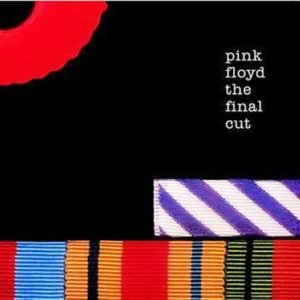Released in 1983, Pink Floyd’s “The Final Cut” stands as a poignant chapter in the band’s storied discography. Arriving on the heels of the monumental success of “The Wall,” “The Final Cut” is often seen as both a continuation and a departure. While it builds on the deeply personal and politically charged themes of its predecessor, it also marks a significant shift in the band’s dynamics and creative direction.
In the broader music landscape of the early 1980s, “The Final Cut” emerged amidst a wave of political unrest and economic turbulence, particularly in the UK. The album’s stark, reflective tone and scathing critique of war and political leadership resonated deeply with the era’s disillusionment. Musically, the album diverged from the progressive rock experimentation that characterized much of Pink Floyd’s earlier work, opting instead for a more stripped-down and narrative-driven approach.
Artistic Intentions
The artistic intentions behind “The Final Cut” are deeply intertwined with Roger Waters’ personal and political sentiments. Described as “a requiem for the post-war dream,” the album grapples with themes of loss, betrayal, and the futility of war. Waters, who took on the role of primary lyricist and creative force following the departure of Richard Wright, infused the album with a raw, emotional intensity. This was not just an album but a deeply personal statement from Waters, addressing the unresolved grief of his father’s death in World War II and criticizing the contemporary political climate under Margaret Thatcher’s leadership.
In interviews and album notes, Waters has expressed that “The Final Cut” was intended to be a scathing indictment of war and the political machinations that perpetuate it. This vision is evident in every track, from the haunting opener “The Post War Dream” to the deeply melancholic “The Gunner’s Dream.” The album’s cinematic quality, enriched by sound effects and orchestral arrangements, underscores its narrative ambition, making it as much a piece of audio theatre as it is a collection of songs.
Sonic Exploration

“The Final Cut” showcases a remarkable level of production quality, reflecting Pink Floyd’s dedication to crafting a sonically immersive experience. Under the meticulous direction of Roger Waters and the engineering expertise of James Guthrie, the album achieves a crisp and pristine sound that contrasts sharply with its often grim subject matter. The production is immaculate, with every instrument and vocal line rendered with exceptional clarity. This high-fidelity approach enhances the album’s dramatic and emotional weight, allowing listeners to fully engage with its narrative depth.
Musical Arrangements
One of the most striking aspects of “The Final Cut” is its musical arrangements. Waters and his collaborators employed a rich tapestry of orchestral elements, seamlessly integrated with the band’s traditional rock instrumentation. The use of orchestration, arranged by Michael Kamen, adds a cinematic grandeur to the album. Tracks like “The Gunner’s Dream” and “Paranoid Eyes” feature lush string sections that elevate the emotional intensity of Waters’ vocals, while the subtle use of sound effects—such as the war planes and explosions in “The Post War Dream”—enhances the storytelling aspect.
David Gilmour’s guitar work, though less prominent than on previous albums, remains a vital component of the album’s sonic landscape. His soulful solos and textured rhythms provide a poignant counterpoint to Waters’ lyrical bleakness. Meanwhile, Nick Mason’s drumming, paired with various percussive elements, creates a dynamic backdrop that ranges from subdued and contemplative to forceful and urgent.
Genre Elements
“The Final Cut” delves into several musical genres and subgenres, though it primarily resides within the realm of progressive rock. However, it also incorporates elements of classical music through its orchestral arrangements, and its narrative-driven structure bears a resemblance to the rock opera format established in “The Wall.” The album’s exploration of these genres is not about blending them in a novel way but rather about using them to serve its thematic and emotional purposes.
What sets “The Final Cut” apart from Pink Floyd’s previous work is its departure from the sprawling, psychedelic soundscapes of albums like “Wish You Were Here” and “Dark Side of the Moon.” Instead, it embraces a more straightforward, almost minimalist approach in its rock elements, focusing heavily on lyrical content and storytelling. This stylistic choice underscores the album’s role as a vessel for Waters’ messages about war, loss, and disillusionment.
Lyrical Analysis

“The Final Cut” is a masterclass in lyrical profundity, with Roger Waters delivering some of his most incisive and personal lyrics to date. The central themes of the album revolve around war, loss, betrayal, and the disillusionment with political leadership. These themes are intricately woven through the lyrics, creating a cohesive narrative that resonates with the listener on multiple levels.
The album opens with “The Post War Dream,” where Waters laments the broken promises of post-World War II society, setting the stage for a critique of contemporary politics and the human cost of conflict. Throughout the album, Waters uses vivid imagery and storytelling to convey his messages. In “The Gunner’s Dream,” he paints a harrowing picture of a soldier’s final moments, juxtaposed with a vision of a world free from fear and conflict. This juxtaposition underscores the tragedy of war and the yearning for peace.
Recurring motifs such as dreams, silence, and the passage of time are prevalent throughout the album. These motifs not only unify the tracks but also deepen the listener’s understanding of the themes. For instance, the recurring imagery of dreams in “The Gunner’s Dream” and “Two Suns in the Sunset” reflects the fragile hopes and unfulfilled promises that haunt the characters in Waters’ narrative.
Lyrical Depth
The lyrical depth of “The Final Cut” is profound, with Waters’ writing blending straightforward storytelling with abstract, poetic expressions. In “Paranoid Eyes,” Waters uses the metaphor of hiding behind “paranoid eyes” to explore the psychological scars of war and the barriers people erect to protect themselves from emotional pain. This combination of direct narrative and layered metaphors invites listeners to delve deeper into the lyrics and uncover the multiple meanings within.
Emotiona Impact
Emotionally, the lyrics of “The Final Cut” are deeply evocative. Waters’ raw, impassioned delivery enhances the emotional impact of the words, whether he is expressing sorrow, anger, or a yearning for redemption. Tracks like “Your Possible Pasts” and “The Fletcher Memorial Home” evoke a sense of profound sadness and anger, as Waters confronts the betrayals of political leaders and the sacrifices of ordinary people. The album’s closing track, “Two Suns in the Sunset,” leaves the listener with a haunting contemplation of mortality and the fleeting nature of human existence.
The emotional resonance of the lyrics is further amplified by their context within the album’s narrative structure. Each song contributes to the overarching story, creating a powerful cumulative effect. The listener is taken on a journey through the psyche of Waters and the characters he portrays, experiencing their pain, disillusionment, and fleeting moments of hope.
Cohesion and Flow

“The Final Cut” exemplifies a remarkable sense of cohesion and flow, both musically and thematically, making it one of the most unified works in Pink Floyd’s catalog. The album’s track progression is meticulously crafted to take the listener on an emotional and narrative journey, with each song seamlessly flowing into the next. This sense of continuity is not merely a result of the musical arrangements but also stems from the thematic and lyrical connections that Roger Waters has woven throughout the album.
The narrative progression of “The Final Cut” is akin to a cinematic experience, with each track serving as a distinct yet interconnected chapter in a larger story. From the opening lament of “The Post War Dream” to the reflective closure of “Two Suns in the Sunset,” the album unfolds with a deliberate pace. The transitions between tracks are smooth, often featuring ambient sound effects or instrumental passages that bridge the gaps, ensuring that the listener remains immersed in the album’s world without abrupt interruptions.
Thematic Consistency
The thematic consistency of the album is one of its most striking features. Waters’ exploration of war, political betrayal, and personal loss is maintained with unwavering intensity throughout the entire record. Each song delves into different facets of these themes, providing a multifaceted perspective on the same overarching issues. For instance, “The Fletcher Memorial Home” offers a scathing critique of political leaders, while “The Gunner’s Dream” and “Your Possible Pasts” explore the human cost of their decisions. This thematic unity reinforces the album’s narrative arc and emotional impact, making it feel like a cohesive whole rather than a collection of disparate tracks.
Musically, “The Final Cut” maintains a consistent style that aligns with its themes. The album’s soundscape is characterized by its orchestral arrangements, evocative sound effects, and the interplay between Waters’ expressive vocals and Gilmour’s poignant guitar work. The recurring use of motifs and musical phrases further enhances the album’s cohesiveness. For example, the haunting saxophone solo in “The Gunner’s Dream” reappears in different forms throughout the album, creating a sense of familiarity and continuity.
There are no jarring shifts in style or tone that disrupt the album’s flow. Instead, any variations in musical intensity or arrangement serve to enhance the emotional trajectory of the narrative. The album’s more introspective moments, such as “Paranoid Eyes,” are balanced by the more intense, anthemic tracks like “Not Now John,” which provides a momentary surge of energy without breaking the overall mood.
Standout Tracks and Moments
“The Final Cut” is replete with standout tracks and memorable moments that underscore its artistic brilliance and emotional depth. While every track contributes to the album’s overarching narrative, certain songs and specific elements within them shine particularly brightly, capturing the essence of Pink Floyd’s and Roger Waters’ creative vision.
Highlight Key Tracks
- “The Gunner’s Dream”: This track is a poignant centerpiece of the album, blending personal reflection with broader social commentary. The narrative of a dying airman envisioning a world of peace and unity is deeply moving. The combination of Waters’ heartfelt vocals, the lush orchestration, and the haunting saxophone solo by Raphael Ravenscroft creates a powerful emotional resonance that lingers long after the song ends.
- “The Fletcher Memorial Home”: This track stands out for its biting critique of political leaders, whom Waters condemns as war-mongering despots. The song’s dramatic arrangement, featuring a soaring guitar solo by David Gilmour and orchestral flourishes, adds a sense of gravitas and urgency. The lyrics are scathing and direct, making it one of the most politically charged songs on the album.
- “Not Now John”: This track provides a sharp contrast to the album’s generally somber tone with its aggressive, rock-oriented energy. Featuring a rare lead vocal from David Gilmour alongside Waters, it addresses the apathy and distraction of society in the face of global issues. The song’s driving rhythm, powerful chorus, and Gilmour’s searing guitar work make it a standout moment of raw intensity.
Memorable Moments
“The Post War Dream”
The album’s opening track sets the stage with a poignant question: “Tell me true, tell me why, was Jesus crucified?” This line immediately immerses the listener in Waters’ introspective and critical exploration of post-war disillusionment. The transition from the hauntingly quiet introduction to the powerful, full-band entry is striking, capturing the listener’s attention right from the start.
“The Gunner’s Dream”
A particularly memorable moment in this track is the lyrical passage, “Floating down, through the clouds / Memories come rushing up to meet me now.” Waters’ delivery, combined with the evocative piano and orchestral backdrop, creates a vivid, almost cinematic experience. The saxophone solo that follows is both mournful and beautiful, encapsulating the song’s emotional core.
“Paranoid Eyes”
This track features a memorable moment where Waters’ voice, tinged with vulnerability, sings, “You believed in their stories of fame, fortune, and glory / Now you’re lost in a haze of alcohol-soft middle-age.” The delicate arrangement, with its gentle piano and subdued instrumentation, perfectly complements the introspective lyrics, highlighting the personal cost of societal pressures.
“Two Suns in the Sunset”
The album’s closing track provides a fittingly somber yet contemplative end. The moment when Waters sings, “The sun is in the east, even though the day is done / Two suns in the sunset, could be the human race is run,” accompanied by the serene yet ominous musical arrangement, leaves a lasting impression. The use of silence and minimalistic instrumentation towards the end of the track creates a sense of finality and reflection.
“Southampton Dock”
This track includes a hauntingly beautiful segment where Waters’ voice, almost breaking with emotion, delivers the lines, “She stands upon Southampton Dock / With her handkerchief and her summer frock.” The simplicity of the acoustic guitar and the rawness of Waters’ vocal performance make this moment particularly evocative and memorable.
Artistic Contribution and Innovation

“The Final Cut” occupies a unique and somewhat contentious place within both the progressive rock genre and the broader music industry. Released in 1983, the album arrived at a time when the music landscape was shifting, with the emergence of new wave, synth-pop, and the early stages of alternative rock. In this context, “The Final Cut” stands out as a deeply introspective and politically charged work that diverged significantly from mainstream trends.
Place in Genre/Industry
Within the progressive rock genre, “The Final Cut” is both a continuation of Pink Floyd’s legacy and a departure from their earlier work. Progressive rock is known for its complex compositions, thematic depth, and innovative use of technology and studio techniques. While “The Final Cut” retains the thematic depth and narrative complexity associated with progressive rock, it eschews the elaborate instrumental passages and expansive soundscapes that characterized albums like “Wish You Were Here” and “Animals.” Instead, it opts for a more direct and stripped-down approach, focusing intensely on lyrics and storytelling.
In the broader music industry, “The Final Cut” is notable for its unabashedly political content and its willingness to confront contemporary issues head-on. At a time when much of popular music was moving towards more commercial and radio-friendly sounds, Pink Floyd released an album that was unflinchingly serious and topical. This bold artistic choice set “The Final Cut” apart from its contemporaries and cemented its status as a work of significant cultural commentary.
Innovation
“The Final Cut” is innovative in several key aspects, particularly in its production, approach to genre, and thematic exploration.
- Production: The album’s production quality is exceptional, with Roger Waters and James Guthrie achieving a sound that is both polished and richly textured. The use of sound effects and field recordings to enhance the storytelling is particularly innovative. For example, the incorporation of war sounds, radio broadcasts, and ambient noise creates an immersive audio environment that draws the listener deeper into the album’s narrative. This use of non-musical elements as integral parts of the composition was ahead of its time and added a cinematic dimension to the listening experience.
- Approach to Genre: While “The Final Cut” is rooted in progressive rock, it incorporates elements from other genres in subtle yet effective ways. The orchestral arrangements, crafted by Michael Kamen, bring a classical music influence that adds emotional weight and sophistication. The album also features moments of straightforward rock, as seen in “Not Now John,” which provides a raw, energetic contrast to the more subdued tracks. This blending of styles, while maintaining a cohesive sound, showcases Pink Floyd’s ability to innovate within and beyond their established genre.
- Thematic Exploration: The album’s thematic focus on war, political corruption, and personal loss is both bold and innovative. While these themes were not new to rock music, the way Waters interweaves them with personal narrative and historical context is unique. “The Final Cut” serves as both a personal catharsis for Waters and a social critique, offering a multifaceted exploration of its themes. The deeply personal nature of the lyrics, combined with their political relevance, creates a powerful and thought-provoking listening experience that challenges the listener to engage with the issues presented.
Closing Thoughts

“The Final Cut” is a deeply compelling and divisive album that showcases Pink Floyd’s ability to blend personal introspection with sharp political commentary. It stands out for its lyrical depth, emotional intensity, and meticulous production, offering a stark and unflinching look at the themes of war, loss, and political disillusionment. Roger Waters’ passionate and often raw vocal performances, combined with David Gilmour’s poignant guitar work and Michael Kamen’s orchestral arrangements, create a rich and immersive listening experience.
Strengths
- Lyrical Depth and Emotional Intensity: Waters’ lyrics are some of his most personal and poignant, effectively conveying the themes of the album. The emotional weight of tracks like “The Gunner’s Dream” and “Two Suns in the Sunset” leaves a lasting impact on listeners.
- Cohesive Narrative and Thematic Consistency: The album flows seamlessly from start to finish, with each track contributing to the overarching narrative. The consistent exploration of its central themes ensures that the album feels like a unified whole.
- Production Quality: The pristine production, innovative use of sound effects, and orchestral arrangements elevate the album’s sonic landscape. The clarity and richness of the sound enhance the storytelling and emotional resonance.
- Artistic Boldness: The album’s willingness to tackle controversial and weighty topics sets it apart from many of its contemporaries. It challenges listeners to reflect on the issues presented, making it a thought-provoking work.
Weaknesses
- Narrow Focus: The album’s intense focus on Waters’ personal and political concerns can make it feel somewhat insular. This narrow focus might limit its appeal to listeners who are less interested in these specific themes.
- Lack of Variety: Compared to Pink Floyd’s earlier work, “The Final Cut” has fewer moments of musical experimentation and instrumental virtuosity. Some fans may miss the more expansive and diverse soundscapes of albums like “Wish You Were Here” and “The Dark Side of the Moon.”
- Tension within the Band: The album’s creation was marked by significant tension within the band, with Waters exerting dominant creative control. This dynamic resulted in a work that is often seen more as a Waters solo project than a true Pink Floyd collaboration.
“The Final Cut” is a powerful and introspective album that stands as a significant, if polarizing, entry in Pink Floyd’s discography. It offers a raw and unfiltered look at Roger Waters’ psyche and his views on contemporary politics, making it a deeply personal and thought-provoking listen. While it may not have the broad appeal of some of the band’s earlier masterpieces, its artistic boldness and emotional depth ensure that it remains a vital and impactful work.
Official Rating
The album earns an 8 out of 10 for its exceptional lyrical content, emotional resonance, and cohesive narrative. Its production quality and innovative use of orchestration and sound effects further enhance its standing. However, the narrow thematic focus and lack of musical variety prevent it from reaching the heights of Pink Floyd’s most celebrated works. Despite these shortcomings, “The Final Cut” remains a powerful and important album that continues to resonate with listeners who appreciate its depth and sincerity.
